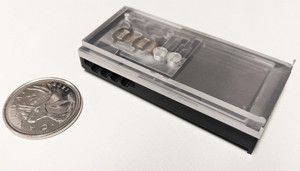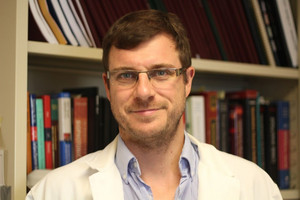A shoebox-sized biomed lab in space

On May 25, the Canadian Space Agency and Impact Canada announced the 20 winning entries in the Deep Space Health Care Challenge, a competition to support the development of new health-care technologies for crews on deep-space missions and residents of Canada’s remote communities.
Université de Montréal’s winning project was submitted by three Quebec chemistry professors with recognized expertise in health technologies: from UdeM, Jean-François Masson, an expert in optical biosensors for disease detection, and Joelle Pelletier, an expert in protein engineering and molecular interactions; and from Université Laval, Denis Boudreau, an expert in nanomaterials and optical instrumentation.
The professors’ entry was selected for its SPRINT technology, which uses smart surface plasmon resonance nanosensors.
“In layman’s terms, we will design a miniature biomedical laboratory whose centrepiece will be a small device that can detect disease biomarkers in a single drop of human blood,” said Masson. “This miniaturized lab will contain all the equipment needed to analyze the sample and it will all fit into a container no bigger than a shoebox.”
Much longer distances
In the coming decades, space missions will face much more complex challenges than the current International Space Station, which is in orbit only 400 kilometres above Earth.
“The cabin of a spacecraft is not very spacious,” Masson noted. “Future missions will carry astronauts distances they have never gone before. They will have to be self-sufficient for all the essentials of life. But there’ll be no room to install a conventional medical lab, even a small one, in the event someone falls ill. So the Canadian Space Agency is calling on the inventiveness of scientists across the country to find solutions.”
“The SPRINT device was inspired by a COVID-19 test we recently developed as part of a study of food workers infected during the pandemic,” he added. “SPRINT will combine two advanced technologies: surface plasmon resonance and passive microfluidic cartridges.
“Surface plasmon resonance is an optical process that uses thin gold film to detect biomarkers of inflammation—that is, proteins in the blood that are associated with a disease. Depending on the biomarkers detected, the instrument will measure a specific colour spectrum.”
Pumped by capillary effect

“At Université Laval, our colleague Denis Boudreau is working on microfluidic cartridges containing the reagent, which will be brought into contact with a drop of blood and pumped passively by capillary effect,” said Masson. “Capillary action is what happens when a liquid is drawn through a surface by surface tension, as when ink spreads through blotting paper.”
Several tiny cartridges the size of a postage stamp will be designed to test for signs of various diseases, including cancer and infections, as well as some of the inflammatory diseases most likely to develop in the sanitized environment of space travel.
The procedure will be quick and easy. If a diagnosis is needed, the astronaut will take the cartridge for the disease he or she wants to test for, deposit a drop of blood in the cartridge, insert it into the SPRINT instrument and launch the software. The total time for the analysis will be less than 15 minutes.
Preparing for the next space station

The Canadian Space Agency is asking scientists to design revolutionary medical devices for the Lunar Gateway Space Station, the next major international manned space mission. The station will orbit the Moon and serve as a staging point for deep-space exploration. Plans call for the first stop to be Mars in about 20 years.
It will take several months to travel to Mars, hence the importance of the astronauts being self-sufficient for a significant length of time.
“It is critical that our miniaturized SPRINT laboratory be able to detect cancer biomarkers, since the astronauts will be working without the protection of Earth’s magnetic field, which shields humans from cosmic radiation,” Masson said. “For the first time in human history, astronauts will be exposed to high doses of solar and cosmic radiation for extended periods of time.”
Scientists suspect this radiation may cause cancer in humans but don’t have enough data to say so with certainty. Documenting the effects of radiation in preparation for deep-space travel will be one of the lunar station’s missions.
Potential for remote communities
The SPRINT instrument’s ability to rapidly and quantitatively detect inflammatory markers will also enable it to screen for many serious diseases.
Because of the lack of clinical laboratories in remote areas on Earth, patients or their blood sample today must travel or be shipped to an urban centre – a time-consuming, expensive and complicated process. Having a diagnostic instrument on hand locally would make it possible to choose the best treatment options for the patient.
SPRINT could therefore revolutionize medical practice in remote areas. Rapid diagnosis on-site would mean follow-up on-site, instead of in distant, difficult-to-reach urban centres. In Canada’s Far North, for example, the distances are enormous.
In addition, the instrument does not require a sterile or aseptic environment or special training to operate; patients could even perform the test themselves. It also eliminates the need for manual collection and injection: after it’s drawn, the blood sample remains in the cartridge, reducing the risk of contamination and destruction. The waiting time for results would also be eliminated, as they would be displayed in 15 minutes.
This technology would therefore be suitable for situations where staff and resources are limited, or where there is high staff turnover. As conceived, it will not require centralized data facilities or peripheral technology, but if necessary the software could be designed to communicate with centralized systems.
“We are ready to work with Canada’s remote communities to identify the applications of the technology that will be most useful for them and to develop a set of cartridges that meet their needs,” said Masson.



